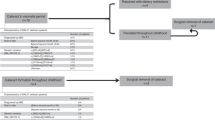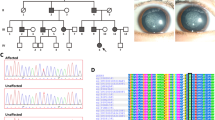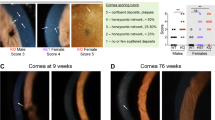Abstract
Glucose-6-phosphate dehydrogenase (G6PD) has an essential role in the defense against cellular oxidative injury. In neonates, the most common manifestation of G6PD deficiency is jaundice and hemolysis due to factors causing oxidative stress. Less known are the ocular associations described with G6PD deficiency, including cataracts. Oxidative injury is involved in the pathogenesis of almost all forms of cataracts, causing the lens proteins to undergo modifications, denaturation and form insoluble aggregates resulting in cataracts. Although cataracts in adult males have been reported in several studies, there are few reports of cataracts in infants with G6PD deficiency. We describe a preterm male neonate with G6PD deficiency who developed bilateral cataracts following an episode of neonatal sepsis and severe hemolysis necessitating an exchange blood transfusion.
This is a preview of subscription content, access via your institution
Access options
Subscribe to this journal
Receive 12 print issues and online access
$259.00 per year
only $21.58 per issue
Buy this article
- Purchase on Springer Link
- Instant access to full article PDF
Prices may be subject to local taxes which are calculated during checkout

Similar content being viewed by others
References
Kaplan M, Hammerman C . Glucose-6-phosphate dehydrogenase deficiency and severe neonatal hyperbilirubinemia: a complexity of interactions between genes and environment. Semin Fetal Neonatal Med 2010; 15 (3): 148–156.
Hatcher G . Glucose-6-phosphate-dehydrogenase deficiency and cataracts. J Am Osteopath Assoc 1981; 80 (9): 615–618.
Yasmin F, Begum N, Ferdousi S . G6PD status in patients with presenile and senile cataract. J Bangladesh Soc Physiol 2011; 6 (1): 1–4.
Orzalesi N, Fossarello M, Sorcinelli R, Schlich U . The relationship between glucose-6-phosphate-dehydrogenase deficiency and cataracts in Sardinia - an epidemiological and biochemical-study. Doc Ophthalmol 1984; 57 (3): 187–201.
Orzalesi N, Sorcinelli R, Guiso G . Increased incidence of cataracts in male-subjects deficient in glucose-6-phosphate-dehydrogenase. Arch Ophthalmol Chic 1981; 99 (1): 69–70.
Assaf AA, Tabbara KF, el-Hazmi MA . Cataracts in glucose-6-phosphate dehydrogenase deficiency. Ophthalmic Paediatr Genet 1993; 14 (2): 81–86.
Zeng LH, Mao WS, Chen YZ, Ma QY . The ocular findings in glucose-6-phosphate dehydrogenase deficiency. Yan Ke Xue Bao 1989; 5 (1-2): 36–38.
Westring DW, Pisciotta AV . Anemia, cataracts, and seizures in patient with glucose-6-phosphate dehydrogenase deficiency. Arch Intern Med 1966; 118 (4): 385–390.
Harley JD, Agar NS, Yoshida A . Glucose-6-phosphate dehydrogenase variants - Gd (+) alexandra associated with neonatal jaundice and gd (-) camperdown in a young man with lamellar cataracts. J Lab Clin Med 1978; 91 (2): 295–300.
Bakhshi S, Kabra M . Glucose-6-phosphate dehydrogenase deficiency with bilateral cataract. Indian Pediatr 2004; 41 (6): 630–631.
Michael R, Bron AJ . The ageing lens and cataract: a model of normal and pathological ageing. Philos Trans R Soc Lond B Biol Sci 2011; 366 (1568): 1278–1292.
Ganea E, Harding JJ . Glutathione-related enzymes and the eye. Curr Eye Res 2006; 31 (1): 1–11.
Berthoud VM, Beyer EC . Oxidative stress, lens gap junctions, and cataracts. Antioxid Redox Sign 2009; 11 (2): 339–353.
Escobar J, Cernada M, Vento M . Oxygen and oxidative stress in the neonatal period. Neo Rev 2011; 12 (11): e613–e624.
Laver NM, Robison WG, Calvin HI, Fu SCJ . Early epithelial lesions in cataracts of GSH-depleted mouse pups. Exp Eye Res 1993; 57 (4): 493–498.
Martensson J, Steinherz R, Jain A, Meister A . Glutathione ester prevents buthionine sulfoximine-induced cataracts and lens epithelial-cell damage. P Natl Acad Sci USA 1989; 86 (22): 8727–8731.
Author information
Authors and Affiliations
Corresponding author
Ethics declarations
Competing interests
The authors declare no conflict of interest.
Rights and permissions
About this article
Cite this article
Nair, V., Hasan, S., Romanchuk, K. et al. Bilateral cataracts associated with glucose-6-phosphate dehydrogenase deficiency. J Perinatol 33, 574–575 (2013). https://doi.org/10.1038/jp.2012.148
Received:
Revised:
Accepted:
Published:
Issue Date:
DOI: https://doi.org/10.1038/jp.2012.148
Keywords
This article is cited by
-
Correcting glucose-6-phosphate dehydrogenase deficiency with a small-molecule activator
Nature Communications (2018)



